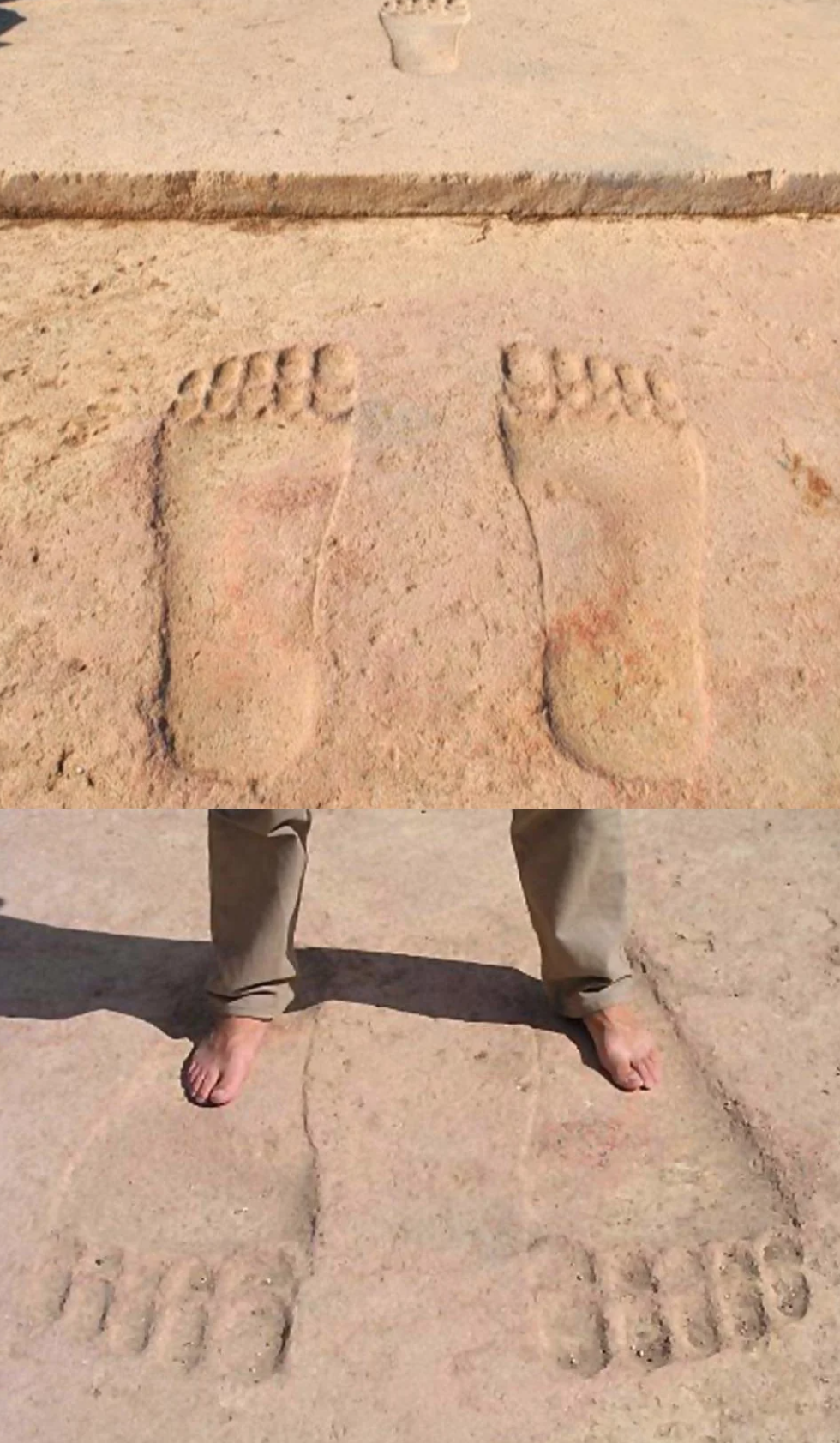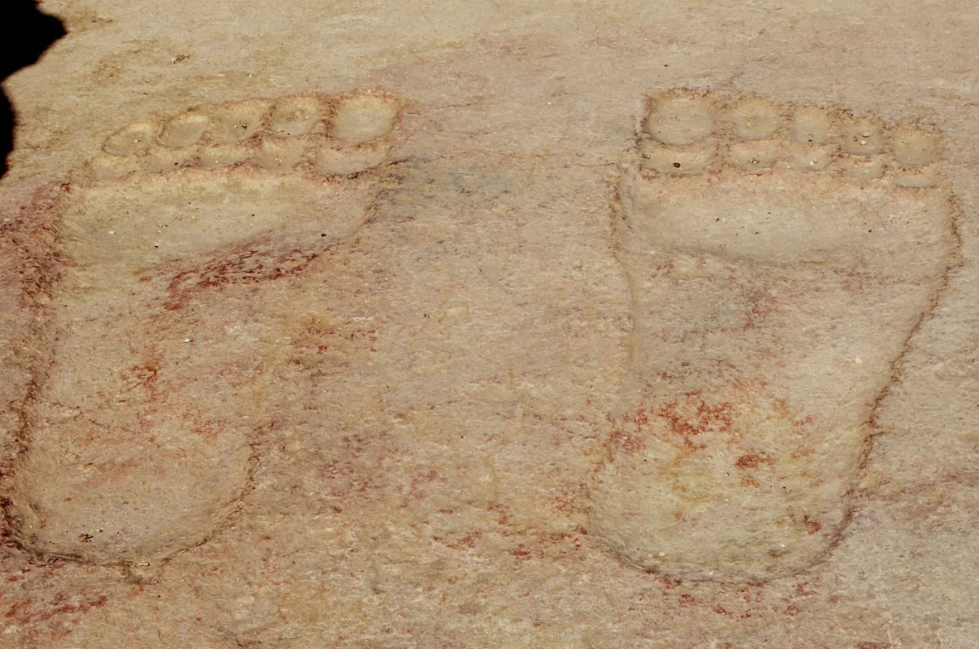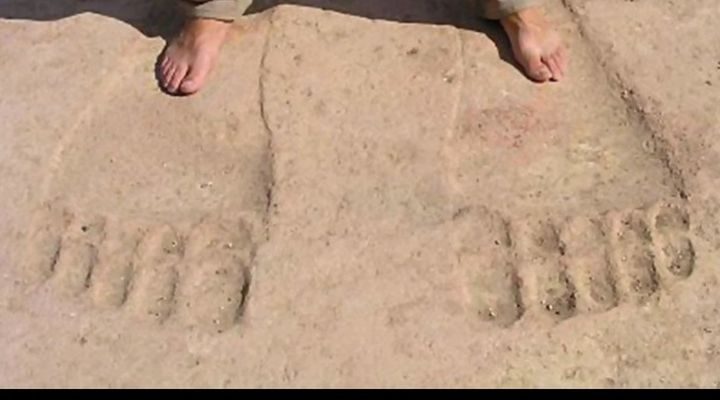Deep in the arid lands of northern Syria can be found an archaeological site like no other. Ain Dara consists of a complex of buildings, built around a large central temple.

But what sets the temple apart are the giant footprints which climb the stairs to the entrance. Far too large to be human footprints, and indented into the solid rock, some believe that these are the footsteps of god, entering his house.
Furthermore, there are marked similarities between Ain Dara and the Temple of Solomon in the Bible. Whatever this coincidence of design means, and whatever the origin or these footprints, the temple provides a powerful reminder of the times when gods were thought to walk among human beings.

The Ain Dara Temple
The Ain Dara temple is believed to be a Syro-Hittite temple from the Iron Age. Initially discovered in 1955, the Ain Dara site was excavated a number of times between 1956 and 1980. According to Ali Abu Assaf, an archaeologist expert on the site, the site and the temple found there had been in use for about 550 years, from 1300 BC to 740 BC.
The temple itself stands on a citadel mound, raised above the surrounding structures. It has a square central chamber with a surrounding rectangular “antecella,” itself surrounded by a gallery on three sides.
The temple is a testament to the craftsmanship and skill of the Syro-Hittite builders, constructed beautifully from basalt blocks on its limestone foundations. Surviving fragments show that when in use it appears it was decorated with geometric reliefs, as well as depictions of sphinxes and lions.

Such creatures, and others more fantastical, are also found on the platform below, guarding the temple, all carved from the huge basalt blocks. In order to reach the portico of the temple, one had to climb the colossal staircase flanked on each side by two lions and a sphinx.
Originally, the building was made up of mudbrick, covered with wood paneling, although this structure is now lost. The decoration continues in the interior, with the walls and façade of the Ain Dara temple covered with hundreds of carved reliefs that depict cherubim, lions, mythical creatures, ornate geometric designs, palmettes, and mountain gods.
But despite this mountain of surviving iconography, archaeologists are still unable to ascertain the deity to whom the Ain Dara Temple was actually dedicated. The prevalent theory is that the temple was dedicated to the goddess of fertility, Ishtar.
However, this is far from certain. Some other groups of researchers and archaeologists suggest that the temple was dedicated to the owner of the sanctuary, the goddess Astarte. Some other groups of people believe that the Ain Dara temple was dedicated to Baal Hadad, a major weather god of the region.
The Temple of Solomon in Syria?
As reconstructed by archaeologists, the temple has many similarities with biblical descriptions of Solomon’s Temple, which it apparently predates. Could this have been the inspiration for the Temple of Solomon? Alternatively could the biblical authors, looking to aggrandize their legendary king, have inserted detail borrowed from Ain Dara?
The layout of the temple is similar to that of the Biblical temple. Both the buildings had the same tripartite plan, which included the main sanctuary hall, an entry porch supported by two columns, and an elevated shrine.
However even though the Ain Dara temple had a number of similar features as the temple of King Solomon, there are some differences. This would suggest Ain Dara was more of an inspiration for the Temple of Solomon, rather than copied wholesale.
The outstanding and unique feature of the Ain Dara temple is the giant footprints that are found on the limestone threshold blocks. The footsteps lie at the entrance of the temple, and measure about 3 feet (1m) in length.
One of the giant footsteps is found on the floor of the portico, then two together, with a final one at the entrance of the main hall. The distance between the footsteps is nearly 30 feet (9.1m). This implies a huge stride, and would suggest whoever was envisioned as having made them would be about 65 feet (20m) high, a giant indeed.
The footprints at the temple entrance (Haubi|Gerhard Haubold / CC BY-SA 4.0)
Carved on the flagstone, the left footstep depicts the god entering the Ain Dara temple. The right footstep, carved at the threshold, indicates that the giant god required just two steps in order to enter the temple.
Dare You Enter the Ploutonion? Gateway to the Underworld at Hierapolis
Is There Proof Ancient Giants Existed?
For worshippers taking many steps to cross the same distance, the appearance of being in the invisible presence of their giant god would be powerful indeed. And the structure of the temple appears to continue on this scale: according to the researchers, the Ain Dara Temple was large enough to allow such a god to enter into it and dwell there.
Other Theories: Ancient Giants?
There are a number of competing theories relating to the giant footprints found at the entrance of the Ain Dara Temple. Other researchers and historians have posited that the giant footsteps could be that of giant humanoid beings who were our forefathers. Some researchers even believe that the giant footsteps could belong to unidentified creatures with immense claws.
Of course, the most prominent and accepted theory is that these footprints were carved by the temple builders themselves. However, the question that comes to mind is what was the real purpose of creating the carving?
Many believe that the footprints could have been designed in order to remember the presence of the gods. It could be some sort of representation of the deity who lived in the temple, to make supplicants immediately aware that they were in the presence of the divine and the inhuman.
Lost Forever
Sadly, these questions will now never be answered. In January 2018 it was reported that the Ain Dara Temple was largely destroyed due to airstrikes by the Turkish Air Force.
According to the reports, the Ain Dara temple was “Blown to Bits” and sustained heavy damage. Looting of the surviving artifacts including the remaining famous basalt lions completed the destruction of the temple, and left only rubble and ruin.
And so, after standing for about 3,000 years, the temple has been destroyed in a local war, for no purpose. Such wanton vandalism highlights how important preserving such sites must be, as it is only through understanding where we come from that we understand ourselves
The temple may be gone but the questions remain. Who was the temple for? Who made the footprints? It is puzzle we may now never solve.



